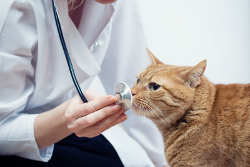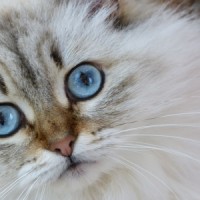In our last article we looked at Ringworms in Cats. Today the focus is on cat thyroid issues.
Cat thyroid problems are a seldom heard of, yet common disease. We all love our little feline friends and want them to live long and healthy lives. While there may not be any catastrophic evidence, as a pet owner we know when something just isn’t right. First, let’s take a look at the two major types of cat thyroid problems and their symptoms.
Hyperthyroidism
Hyperthyroidism is by far the most common glandular disease among felines. It occurs when the cats thyroid produces too much of hormone (thyroxine, also known as T4) and is usually found in cats from 10-14 years old. This over production causes the cat’s metabolism to skyrocket, thus overworking all the other organs. Take the heart for example, hyperthyroidism can cause it to beat extremely fast causing problems with the heart muscle itself, and if untreated can lead to heightened blood pressure.Some of the symptoms of hyperthyroidism are:
- Weight loss: If left alone not only will your cat lose fat, but also valuable muscle mass.
- Excessive thirst and urination. The high metabolic rate will cause the cat to be thirsty and the kidneys to be hyperactive.
- An ‘un-kept’ appearance. You cat’s fur may lose it’s luster and shine and dry skin may cause excessive dandruff.
- Vomiting and diarrhea sporadically.
Hypothyroidism
The opposite of what we just discussed, hypothyroidism is caused when the thyroid produces too little thyroxine and metabolism slows down drastically. Hypothyroidism is not as common and is often caused by treatment for hyperthyroidism bringing thyroid production to low.
When concerned that your cat may have hypothyroidism, look for the following:
- Weight gain, even though he/she is eating normally.
- No energy/desire to play.
- Noticeable loss of appetite.
- Fur in poor condition and dry skin/Dandruff.
- Constipation.
- Not tolerating cool temperatures.
These are just a few of the symptoms to look for if you are concerned your cat may be experiencing thyroid problems. It is not an all inclusive list, and many of the syptoms are common with other diseases as well (diabetes, heart disease, etc.).
Does Your Cat Have Thyroid Problems?
The only way to know if your cat has a thyroid problem is to have it checked by a vet. A blood test as well as checking the thyroid gland in the neck for swelling will help determine if treatment is needed.
How are Cat Thyroid Problems Treated?
Depending on evaluation results, your vet may choose one or more of the following options. Each has their advantages and disadvantages.
- Medication. The most common treatment, this will get your cat’s thyroid levels where they should be in a matter of weeks. However, daily medication is usually required for the remainder of your cat’s life.
- Surgery. This option will remove the affected thyroid gland (your little ball of joy has two) since a high percentage of cases are caused by a tumor. Anesthesia can be a problem though, since this disease affects older cats that may have other conditions as well.
- Radioactive Iodine. An injection is placed under your cats skin. The medicine concentrates in the thyroid gland and destroys the tissue causing the problem. It is a one time treatment, but can be pricey to the tune of near $1000. Also, the radioactive medicine can be hard on an older cat’s kidneys.
How to Prevent Cat Thyroid Problems
There are no guaranteed ways to prevent your cat from thyroid disease, but there are a few steps you can take to reduce the risk. For starters, keep your cat on a healthy diet and good supplements/vitamins throughout their life. The less the amount of exposure to household cleaning chemicals, antibiotics, x-rays, and food preservatives the better. With a little bit of extra love and caution in these areas you can greatly reduce the likely hood of your furry friend succumbing to thyroid problems.
In our next post we focus on supporting your Feline with Cat Arthritis.
Thanks for visiting, if you liked this article please like us using the side bar .



Comments are closed.